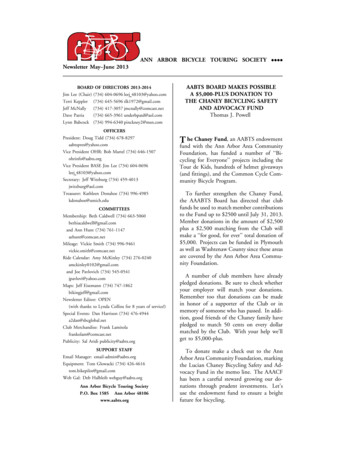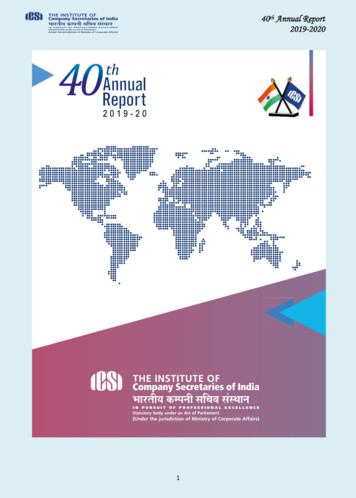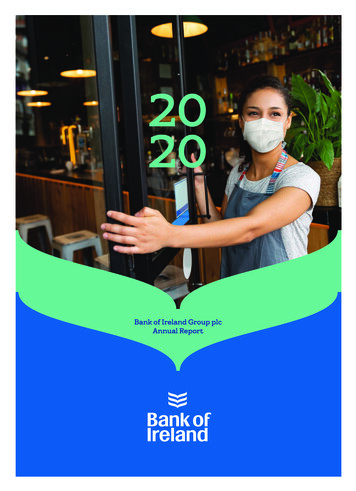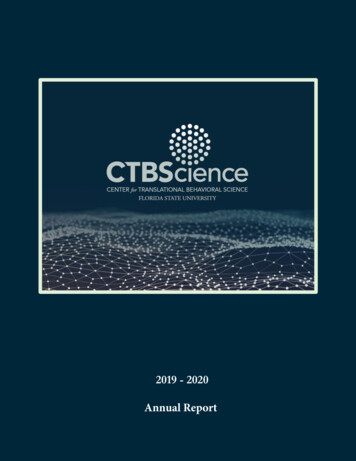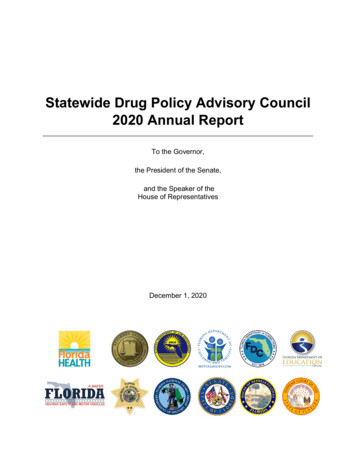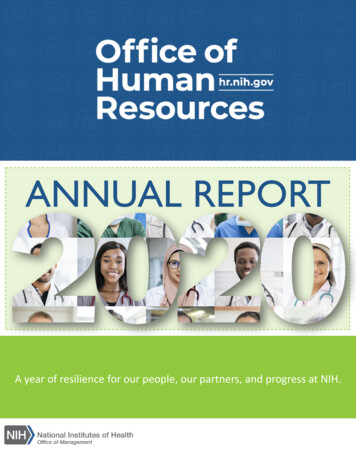
Transcription
ANNUAL REPORTA year of resilience for our people, our partners, and progress at NIH.
LETTER FROMTHE DIRECTOR2020 brought unprecedented challenges for theworld, our country and for our community at theNational Institutes of Health (NIH). Here in the NIHOffice of Human Resources (OHR), we are proud ofthe work that we did to support the NIH workforceover the last year and continue to do. It becamequickly apparent with the onset of the COVID-19pandemic that our role in supporting the NIHcommunity would require OHR to be agile incompletely unexpected ways to support NIHleadership and our workforce. Due to our strongembrace of workplace flexibilities and dynamicprograms, OHR was prepared and ready withsolutions to continue meeting our employees’ andcustomers’ needs.One of OHR’s greatest accomplishments in 2020 is astronger and re-energized partnership with ourcustomers across the NIH. There were numerouscritical response efforts and national initiatives beingled by our customers in the Institutes and Centers,which required OHR to be at the table ready tosupport recruitment, onboarding, and training needs.We recognized early on that greater communicationand flexibility were necessary as we helped customersnavigate new HR regulations and policies such as theFamily First Coronavirus Response Act (FFCRA) andincreased workplace flexibilities. All-Staff meetingswith the Executive Officers were scheduled to answerquestions staff might have as the situation continuedto evolve.I am also proud that we delivered on commitmentssuch as launching the Total Compensation Tool. Wealso improved access to data analytics acrossprograms and services areas through efforts toestablish organizational standards, and completed thedevelopment of the SBRBPAS Framework, which willhelp NIH recruit and retain highly specializedcandidates in the critical areas of biomedical andclinical research and product assessment. Togetherwith our customers, OHR created opportunities,collaborated in new ways, modernized workflows,and successfully helped our customers meet theirhuman resource needs.In addition to our work to support the NIH workforceas a whole, I am incredibly proud we were able tosupport OHR staff in optimal ways. I recognize that2020 presented complex and unique challenges forour staff as we shifted overnight to a completelyvirtual environment. In response, we offered virtualtrainings and development sessions, had multipletouchpoints via virtual town halls and socials, andmost importantly, helped OHR staff leverageworkplace flexibilities to the greatest extent possibleto support their work/life fit. I’ve been inspired by theresilience of our team here in OHR, and the entireOHR Senior Leadership team is steadfast in ourcommitment to cultivate a positive EmployeeExperience as we look towards the future of thisorganization.The future will look different for all of us and indifferent ways. A priority for OHR is to improve ourprocesses and create programs and services that willoffer the best Customer Experience at the federallevel and in the biomedical research community. Iinvite you to read ahead to see the progress we’vemade.As we press on into 2021, the talented scientists andresearchers at the NIH will continue their criticalresearch to make important discoveries that improvehealth and save lives, and the NIH Office of HumanResources remain by their side and committed tosupport the NIH workforce.We are the PEOPLE that build the PARTNERS to drivePROGRESS of the National Institutes of Hope.Sincerely,Julie Broussard Berko, MPANIH Chief People Officer2
2020 COVID-19 TIMELINEMAR 13JAN 21CDC Confirmsfirst USCoronaviruscase.PresidentdeclaresCOVID-19a nationalemergency.NIH IntramuralResearch Programshifts to missioncritical work only.MAR 13JAN 31United StatesDeclares PublicHealthEmergency.MAR 23NIH beginsmaximumtelework.NIH TrainingCenter goes100% online inresponse tomaximumtelework.MAR 16OHR participatesin first NIH AllStaff VirtualTown Hall Event.MAR 20OHR Launches‘Ask OHR’ toaddress HR policychanges and otherworkforce issuesthat emerged as aresult of thepandemic.OHR participatesin second NIH AllStaff Virtual TownHall Event.APR 24MAR 25Throughout 2020 the NIHTraining Center offered650 virtual classeswhich is an increase in totalclasses from previous years.740Questions submittedfrom staff to NIHleadership for VirtualTown Hall.19,998NIH staff participate inApril virtual town hall.
2020 COVID-19 TIMELINEJUN 22NIH Group AStaff beginreturning tophysicalworkspaces inMaryland andMontana.NIH Return tothe PhysicalWorkplaceFrameworkvideopresented byOHR’sDirector isreleased tostaff.OHRparticipatesin third NIHAll-StaffVirtualTown HallEvent.MAY 21MAY 1516,783Applicants received for100 COVID relatedannouncements.JUL 20NIH Group BStaff beginreturning tophysicalworkspaces inMaryland andMontana.OHRparticipatesin fourthNIH All-StaffVirtualTown HallEvent.OHRparticipatesin fifth NIHAll-StaffVirtual TownHall Event.SEP 18DEC 22DEC 18FDA issuesEmergency UseAuthorizationfor Moderna/NIAID codevelopedCOVID vaccine.OHR host firstvirtualbenefits fairfor OpenSeason.NOV 13HHS & NIHpartner tohost aCOVID-19VaccineKick-OffEvent onNIHBethesdaCampus.OHRparticipatesin sixth NIHAll-StaffVirtualTown HallEvent.NOV 20JUN 193.6Mhr.nih.govPage views across OHR’swebsite with top hits toJobs at NIH, HR Systems,and Working at NIH.Total pageviewsof OHR’s redesignedBenefits Open Seasonwebpage that included3 new ‘how-to’ videos.13,800
WHONIH Office of Human Resources WEAREMISSIONTo recruit and retain a highlyskilled and diverse workforce forthe NIH.VISIONTo be a catalyst for a thrivingworkforce that best meets theever-changing needs ofbiomedical research.362OHR FULL-TIME EQUIVALENT (FTE)as of 12/31/2020Compensation & PolicyDivisionCSDClient s goal is to be the peoplethat build the partners to drivethe progress of the NIH mission.This is achieved through theunique skills every staff memberbrings to the Office of HumanResources.OIMPIMODOffice of InternalManagement andPlanningCPDVALUESImmediate Officeof the DirectorDSSEMSAIDDivision of Senior &Scientific ExecutiveManagementSystems, Analytics, andInformation DivisionHR Specialists and HR Assistants make up 74%of OHR’s workforce. These are the staff thatcustomers commonly interact with completingactivities such as recruitment, onboarding,benefits, etc.WRDWorkforce RelationsDivisionWSDDWorkforce Support &Development Division26%The remaining OHR workforce is comprised of variouspositions that directly contribute to the managementand operations of HR. These include IT Specialists whosupport key HR systems and analytics, TrainingSpecialists that oversee the technical and professionaldevelopment of NIH staff, and NIH PresidentialManagement Fellows and Management Interns.5
WEBELIEVEIN OURPEOPLE
NIH WORKFORCE19,315Total FTEHeadcount1% increasesince 201711.38AT A GLANCE21%5.55AverageNumber ofYears at NIHFTEs Eligible to RetireAverage Number ofYears FTEs Stayed PastRetirement EligibilityIn 5 years, 37% of thecurrent FTEs will beeligible to retireData as of 1/1/2021Geographical Areas Where NIH Staff Are LocatedData as of March 2020OHR services NIH stafflocated in federal facilitiesacross five states:ArizonaMarylandMassachusettsMontanaNorth CarolinaShown shaded in green.In addition, approximately1.12% of the NIH federalworkforce worked full-timeremote prior to the COVID19 pandemic across the USand internationally. USremote worker locations areindicated by the red dots.Top 5 Most Populous Occupational SeriesData as of 1/1/2021Percent Eligible to Retire NowCount of FTEs0601 General Health Science3,5330401 General Biological Science0602 Medical Officer2,61521%18%30%1,6560610 Nurse1,2740301 Misc. Administration & Program1,26517%23%7
SERVICING A DIVERSE WORKFORCEOHR provides full support over the course of the employee lifecycle to 11 of 17 different types ofpositions at NIH.Title 5 - GSTitle 42 Tenure Track &Tenured InvestigatorsTitle 5 - WGTitle 38SES / ExecutiveTitle 42SSO or SPL-2Title 42 Clinical orResearch FellowTitle 42Staff/Senior Clinicianor ScientistSenior BiomedicalResearch ServiceTraineeVisiting FellowsCommissionedCorpsTraineesSummer InternsTraineesIRTAs and CRTAsVolunteers & SpecialVolunteersGuest ResearchersContractorsTitle 42 UndergradScholarship Program(WGSP)8
GREAT SCIENCE BEGINS WITH AGREAT WORKFORCEThe Federal Employee Viewpoint Survey (FEVS) is an annual survey administered byOPM that measures Federal Government employees’ perceptions about their workexperiences, organizations, and leaders. In 2020, OPM removed 34 of the 72 corequestions to add questions related to the pandemic. Employee engagement data isthen used by the Partnership for Public Service and the Boston Consulting Group torank The Best Places to Work in the Federal Government.NIH 2020 RESPONSE RATE68.0%ALL 1.6%Following a 100%virtual FEVS campaign,NIH’s response rategrew again in 2020 toour highest rate ever!of the original questions from the2019 FEVS stayed the same or increased.OHR also created interactive data visualization tools for NIH Institutes and Centersto better access and use FEVS data to create positive changes through theorganization.9
VALUING PEOPLE STARTS WITHINIn OHR we are passionate about people and the work begins within. We work diligently tosupport and engage the talented professionals that make up the staff of the Office ofHuman Resources, even when there is not a global pandemic. This focus on our people isreflected in OHR’s 2020 Federal Employee Viewpoint Survey Results as shown to the right.In addition to these impressive results, we are proud to say that 96% of staff feel theirsupervisor supports their needs to balance work and other life issues andrecommend OHR as a good place to work.94%Over the past year, staff have showed true resilience as they transitioned to a fully virtualwork environment all while continuing to provide excellent service to all our customers. Inorder to support this transition, OHR’s own Administrative Services Branch (ASB) organizedthe first Supply Pick-up Event designed to provide staff with much needed supplies, whilemaintaining a safe distance!OHR’s Engagement and Development Branch delivered numerous trainings to increaseoverall comfort and effectiveness in our new virtual environment. In addition, staff engagein our ‘OneOHR’ Yammer group to stay connected with one another and even encouragephysical activity through stretch breaks and team step challenges. Last, but not least, staffformed the OHR Social Committee to deliver quarterly OHR Social events to help formconnections, lift spirits, and drive our commitment to elevating the OHR EmployeeExperience.OHR SupplyPick-Up EventOHR Take Your Child to (Tele)Work DayOHR hosted our first Take Your Child to (Tele)Work Daywhich included a full day of facilitated and DIY sessionsto educate #OHRKids about the important work beingdone at the NIH by their parents.OHR Fall SocialStaff-hosted virtual games or discussions tohelp facilitate important social connectionsoutside of the physical workspace.Supply kitsprepared for staffto drive-by andpick-up fromOHR staff includingA surprise appearance byJulie Berko and myself!Despite the drearyweather, we helpeddeliver 50 kits and 20special equipmentrequests.“We are passionate aboutpeople and the work beginswithin.”Beth Ilana ChandlerDeputy Director, Office of Human Resources10
INCREASED NIH STAFFING LEVELSOver the course of 2020, the Client Services Division (CSD) was able to increaseNIH’s staffing levels to their highest level since the hiring surge in Fiscal Year 2017.CSD accomplished this during an unprecedented time full of many unknowns.Nevertheless, hires outpaced separations for all but two months in Fiscal Year2020. CSD’s versatility and their established structure supported their ability toreach the NIH goal of raising its staffing levels even while adjusting to a fullremote work environment.In addition to hiring more staff, CSD received contract funding to set-up a sharedservice center of former HR staff to handle more routine work like buildingannouncements, reviewing applicants, and building assessments. This internalgrowth allowed OHR to facilitate the vital work necessary to increase NIH stafflevels and lead to success expected to continue into Fiscal Year 2021.2,564 26%OVERALLHIRES2,057FY19FY20NIH TRAININGGOES FULLY Even before maximum telework commenced, the NIH TrainingCenter began to thoughtfully consider which courses couldcontinue to run online and how to address the impact onleadership programs, mandatory training, and closed enrollmenttrainings. As a result, the NIHTC was able to quickly implementan enterprise-wide game plan almost instantly to take the all oftheir training and services virtual by March 16. In addition, theStrategic Workforce Analytics and Engagement Branchsuccessfully converted the NIH’s New Employee Orientation to afully virtual format in order to sustain onboarding duringmaximum telework and beyond which has received 13,335pageviews since dershipProgram Cohorts11
THE FIRSTVIRTUAL NIH DIRECTOR’SAWARDSThe NIH Director’s Awards are prestigious awards whichrecognize the greatest achievements of all Institutes and Centers. Eachnomination undergoes a rigorous review process which includes each ICDirector, the NIH Awards Review Committee, and a selection by the NIHDirector for special recognition. Approximately 2% of NIH staff are recognizedfor their notable accomplishments each year.Despite restrictions preventing in-person gatherings, OHR developed aninnovative and personalized virtual recognition program for over 660 awardrecipients. A comprehensive website lists recipients by category and IC andincludes videos from each IC’s senior leadership as well as a special message,and song, from NIH Director, Dr. Francis Collins.SAFELY RETURING NIH STAFF TOTHE PHYSICAL WORKSPACEIn the face of an unprecedented pandemic, a major responsibility was thedevelopment of a framework that would help the NIH workforce navigate aslow and steady return on site to support the NIH mission and continue timesensitive research such as that being done on the SARS-COV-2 virus, patientcare responsibilities, and other critical campus functions. The NIH Return to thePhysical Workspace Framework was designed when the world was still trying tounderstand a novel virus and the COVID-19 illness. No firm models for thisprocess existed, although preliminary plans and emerging information aboutnumerous medical facilities, universities, and other businesses and governmentorganizations were reviewed in the development of the NIH framework.To facilitate a gradual return on site, the Framework identified key Groupsaligned with carefully considered guidelines for return. Each Group requiredvigilant data collection, review, and analysis. In order to have the necessarydata, OHR partnered with NIH’s Center for Information Technology (CIT) toaccurately record each employee's status in the NIH Employee Directory (NED).To accommodate staff in the voluntary return group, OHR staff workedinternally to rapidly develop a web-based application for automated processingfor a more efficient review and approval process.As the situation continues to evolve, and NIH’s plan to return employees to thephysical workspace develops, OHR remains agile and at the ready to bestsupport the workforce and the life-saving mission of the NIH.12
PARTNERSARE OURPURPOSE
OPTIMIZE NIHTITLE 42PROCESSINGTitle 42 Processing was chosen by NIHleadership to be part of Phase II of the initiative in January 2018. The overall goalof the initiative has been to streamline the Title 42(f) hiring process and improvetime to hire by reducing bottlenecks and unnecessary layers between theInstitutes and Centers (ICs), the Office of Human Resources (OHR), the Office ofIntramural Research (OIR), and the Office of Extramural Research (OER) in additionto sharing best practices. To accomplish the work of this initiative, they stood upthree working groups:EVALUATE MIn 2020, the Evaluate Current State Workgroup completed their current stateassessment and documented their findings in a detailed report. The StandardizeProcesses Workgroup developed detailed process maps that were used to identifyopportunities to remove or streamline steps in the recruitment process. Therecommendations they identified could significantly reduce the time to hire byapproximately 37%. These workgroups presented their findings andrecommendations to the initiative’s Advisory Committee which were thenapproved in November.In 2021, the team will present the recommendations to key stakeholders in OIR,OER, and the NIH community. In addition, they will work to develop new tools andguidance that will support the streamlined process to be implemented throughoutthe year. This initiative has demonstrated the importance of trans-NIHpartnerships and the power of combining HR subject matter experts with those inour Institutes and Centers executing these processes.SBRBPASThe Silvio O. Conte Senior Biomedical Researchand Biomedical Product Assessment Service(SBRBPAS) is a mechanism designed to recruitand retain outstanding and qualified scientificand technical experts in the fields of biomedicalresearch, clinical research evaluation, and biomedical product assessment.Following HHS guidance issued in late 2020, OHR convened a workgroup with keystakeholders to develop guidance, outline the slot allocation process, developposition statements, recruitment and peer/pay review processes.LAUNCHOHR deployed SBRBPAS on March 31, 2021.14
PROVIDINGSPECIALPOLICY SUPPORTIN RESPONSE TO THE PANDEMICCOVID-19 brought about many changes to the way we do work, which promptedthe need for new policy and guidance for both leadership and staff. OHR hasplayed an essential role in reviewing and interpreting new policy as well asdeveloping NIH-specific policy necessary to support the workforce during theseunprecedented times. OHR’s Workforce Relations Division (WRD) and theCompensation and Policy Division (CPD) partnered across NIH to provide guidanceand even create new policies which were critical in the early stages of thepandemic.Weather & Safety LeaveAdministrative LeavePayroll Tax WithholdingDefermentRestoration of AnnualLeave for COVID PurposesHazard Duty Pay andEnvironmental Differential PayModified HHS TeleworkPolicy: Dependent CareFamilies First CoronavirusRelief Act: Emergency PaidSick Leave ActNational DefenseAuthorization Act (NDAA)Special Hiring AuthoritiesEXECUTIVE RECRUITMENTAND ONBOARDINGRecruitment of critical positions did not slow down in themidst of COVID-19. In 2020, the Division of Senior Scientificand Executive Management‘s (DSSEM) Recruitment andOnboarding Teams successfully completed 22 executiverecruitments and onboarded 16 executives in 2020, withmost completed totally virtually.The 22 recruitments, included a record number of five ICDirectors during a one-year period, resulting in theOnboarding Team scheduling a full-day of 2nd levelinterviews for over 23 candidates in addition to providingsynthesizing CenterDirectors15
PROGRESSDRIVESTHENIH MISSION
WORKPLACECLIMATE & HARASSMENTSURVEYOHR TAKES ONAs part of the NIH Anti-HarassmentProgram, a Workplace Climate andHarassment Survey is administered to NIH staff including NIHemployees, contractors, fellows, and trainees. In 2020, OHRassumed responsibility for this vital tool for assessing workplaceclimate and in identifying elements of NIH’s organizationalclimate associated with harassment. First administered in 2019,OHR will administer the next survey planned for 2022 in closepartnership between OHR’s Strategic Workforce Analytics teamand the NIH Civil Program.PERFORMANCE AWARDSREPORTING SYSTEMIMPLEMENTATIONHRSAID, in partnership with WRD and CSD, moved the annual data call modulefrom SMARTHR to the Performance Awards Reporting System (PARS). PARSprovides IC customers a secure and efficient way to submit PMAP ratings andawards to OHR. It enforces business rules, eliminates inconsistencies, andestablishes a single version of PMAP activity across the organization. PARS officiallylaunched in January 2021 and ICs began submitting their PMAP data electronicallythrough PARS for the 2021 PMAP season.ICs were provided with some new functions, which included:Confirming IC awards percentages prior to PMAP data submissionAdding the flexibility of incremental Excel spreadsheet uploadsRedesigning the Summary Awards Dashboard?PARS First Impression: Testing FeedbackThe look ofit is easy tofollow.17
DEVELOPMENT OFCOVID-SPECIFIC WEB TOOLSIn support of several new, and often complex, pay policies OHR’s Systems,Analytics, and Information Division (SAID) accelerated development of new webtools designed to help staff determine eligibility and even calculate complex paychanges.In partnership with other OHR Divisions, the SAID team developed web-basedguidance for NIH staff on OHR’s website for use of Hazardous Duty Pay,Environmental Pay, and Evacuation Pay. This page received 12,184 page visits sinceits launch in June 2020.In addition to guidance on new pay policies, OHR’s SAIDteam developed a dynamic online tool in response tothe announcement of the Emergency Paid Sick LeaveAct (EPSLA), which provided employees up to 80 hoursof paid sick leave for specific circumstances related toCOVID-19. The EPSLA Eligibility Tool was designed toallow NIH Employees to quickly determine eligibilityand pay entitlements under this new act. This new toolreceived 7,417 page visits since its launch in June2020.TOTAL COMPENSATIONWEBPAGE LAUNCHIn the Spring of 2020, OHR launched theTotal Compensation website designed toprovide details on the full array of available compensation as an NIH employee. Theweb tool compiles details about not just salary, but also the benefits, awards, leave,retirement and other incentives employees may receive as an NIH employee. Sincelaunch, the page has had over 3,780 hits and is linked directly from USA Jobs toallow job seekers to easily access this information. Employees can also access amore comprehensive picture of theirtangible compensation, including salary,benefits and retirement information fromthe page.818
OHR’sSTRATEGIC PLANYEARTWOThe OHR Strategic Plan is a multi-year process designed to serve as our organization’scornerstone and support OHR’s 3 core values: People, Partners, and Progress. Theplan serves to remind all OHR staff of our organization’s long-term priorities whileallowing us to remain agile to external requests and the changing needs of ourcustomers.In 2020, the three Strategic Plan working groups each successfully completed theirgoal, despite the pivot to maximum telework and shifting priorities that arose withthe COVID-19 pandemic. 29 OHR staff members actively participated in these efforts.Specifically, the People group developed a process, guidelines, and implementationplan for ICON – an informal shadowing and project-based collaboration program; thePartners group developed recommendations for improving the OHR customerexperience and designating currently siloed efforts as a cohesive program; and theProgress group identified opportunities to enhance OHR staff application andunderstanding of analytic tools to ensure consistent data reporting and improveawareness and usage of such tools.The OHR Strategic Plan is developed with input from all levels of staff and continuesto become a stronger foundational component of OHR every year. It is OHRleadership’s commitment that we will be the people that build the partners to driveprogress for NIH.PEOPLECultivate OneOHRCultureTHEFUTUREOF WORKPARTNERSBe the Customer’sFirst ChoicePROGRESSPlan for the Futureof WorkChange is inevitable, and 2020 and the COVID-19pandemic have dramatically altered the way manyorganizations approach work. The NIH workforce hasrelied on many workplace flexibilities to meet the needsof staff and their families, while continuing the criticallifesaving work at the core of the NIH’s mission.Over the last year, OHR has formed a committee dedicated to examining updatedguidance and policies as well as lessons learned as a result of the pandemic and ourmaximum telework experience. OHR recognizes that flexibility will continue to bekey in not just recruitment, but also the retention, of our diverse workforce. OHRwill continue to review and update policies to support a hybrid workforce of thefuture.819
FTEs Eligible to Retire. In 5 years, 37% of the current FTEs will be eligible to retire. Data as of 1/1/2021. Geographical Areas Where NIH Staff Are Located. Data as of March 2020. OHR services NIH staff located in federal facilities across five states: Arizona. Maryland. Massachusetts.
